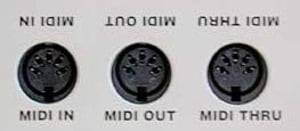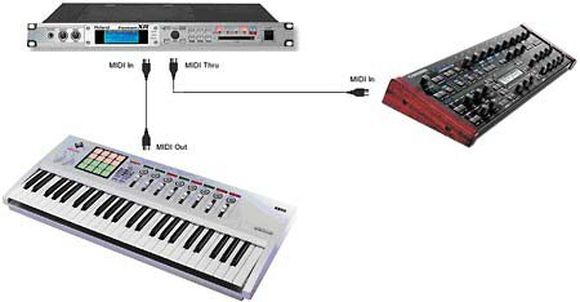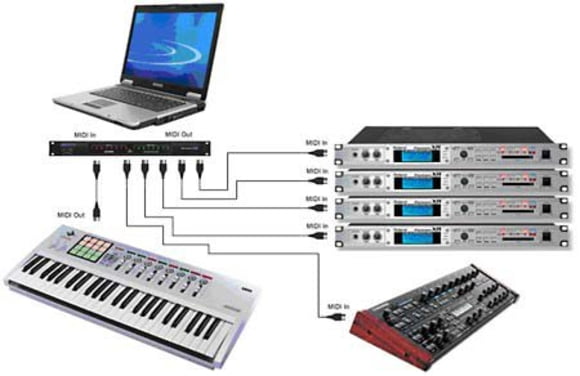3. Interface Technologies
There are 3 kinds of MIDI connection - MIDI In, MIDI Out and MIDI Thru. Physically they are round, 5 pin female sockets, identical to the old DIN audio format, but wired differently - you must use a MIDI-specific 5 pin male to male cable.

- MIDI In this port accepts MIDI data into the device, so you might connect to this port on a sound module from the MIDI Out port of a keyboard or computer interface for example.
- MIDI Out this sends MIDI data out of the device most often a keyboard or a computer controlling a sound module.
- MIDI Thru largely unused these days due to the prevalence of multi-port interfaces, it sends out an exact copy of whatever data arrives at the devices MIDI In. This allows you to chain MIDI devices together, so for instance, you could play two sound modules simultaneously from a single keyboard in this instance the MIDI Out of the keyboard would go to the MIDI In of the first sound module, whose MIDI Thru would then be connected to the MIDI In of the second sound module; whatever you play on the keyboard now goes to both modules.
Computer MIDI interfaces these days generally come with multiple MIDI Outs, and so no chaining is really required as you can connect and address each sound module individually. The sequencer software running on the computer then allows you to route from your keyboard to whatever MIDI Out(s) you wish. This is both more reliable and offers greater bandwidth than chaining via MIDI Thrus.
Lets look at a couple of example setups:
Traditional keyboard to sound module MIDI connection:
Each MIDI port can contain up to 16 channels of independent MIDI information. This means that you could be playing a different instrument on each MIDI channel, or different sounds on different channels of the same instrument, providing it is multitimbral. In the arrangement above, the first sound module could be set to respond on Channel 1, and the second sound module on Channel 2. The keyboard could then switch between the two modules by changing its MIDI send channel.
Computer-centred setup - keyboard to sequencer to module:
Computers do not usually have MIDI built in, although you may find a simple MIDI In/Out interface provided on onboard soundcards. To equip your computer to control any amount of MIDI gear, youll need to attach a hardware MIDI interface the main subject of this article. These provide up to 8 ports, and you can stack them to provide even more if you need them. Typically, the interface will connect to the computer via USB.
In recent times, manufacturers have started to bypass the MIDI interface by providing USB sockets on their keyboards, sound modules and controllers - this allows you to connect your keyboard directly to the computer without the need of a MIDI interface. When coupled with the fact that so much of the sound generation traditionally done by sound modules is now done inside the computer, it did seem like the days of external MIDI modules were numbered. However, hardware still prevails in the areas of simplicity, tactile response and reliability, and its always handy to have sockets available for any older gear that might turn up in your studio - rumours of the MIDI interfaces decline have been largely overstated. That said, a USB equipped keyboard and a computer full of sounds may be all youll ever need, but then theres a lot more going on over MIDI than simply playing sounds





